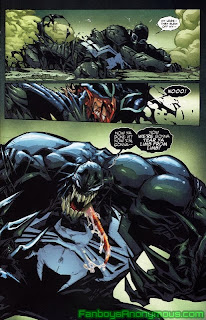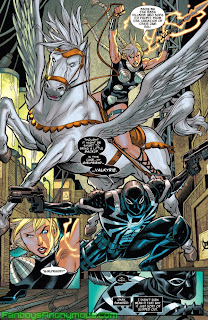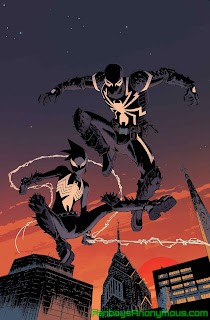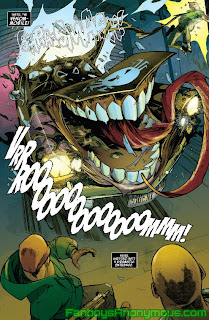Expectations, excitement, and anxiety soared upon the announcement of a new ongoing Venom comic book series by Rick Remender (w) and Tony Moore (a), promising a new kind of Venom and a new host after 6 years under the torment of fan-hated host MacDonald Gargan—formerly and once again Spider-Man's long-time nemesis, the Scorpion. I, for one, didn't mind Mac-Venom during his run—I embrace each and every symbiote host, good, bad, or ugly—but even I longed for the good ol' Venom: Lethal Protector days when Eddie still wore the suit. What came in 2011 either blew away expectations or shattered childhoods, according to who you talk to.
In the pages of The Amazing Spider-Man #654 a back-up story by Dan Slott (w), Paulo Siqueria (a), and Ronan Cliquet (a) titled "Rebirth" debuted Eugene "Flash" Thompson—Peter Parker's once high school bully turned best friend and avid Spider-Fan—as who would become one of the most popular symbiote hosts: Agent Venom. Fan reaction was grim and mistrusting in Agent Venom's early days, and many—including myself, to some degree—pined about the militaristic approach to our favorite character. Many to this day still refuse to accept Flash as Venom, but the character has grown to become almost as big of a cult favorite character as the original Venom. It's easy to measure Agent Venom's ever-increasing popularity: he received his own Marvel Select action figure just months before Eddie (not counting the Ultimate version), will receive his own Marvel Legends figure before Eddie, and will make his debut in the animated Ultimate Spider-Man television series before Eddie (Venom debuted in season one, but bonded to Harry Osborn). Additionally, many speculate Flash's iteration of the character would be an ideal and probable candidate for the promised Venom spinoff film.
Agent Venom enjoyed a moderately and relatively successful career: in addition to his main title, Flash joined the Secret Avengers for a short stint resulting in one of the hottest romantic pairings with the Valkyrie of Asgard (which was later revisited in the also-cancelled Fearless Defenders series); threw down with Carnage (the Venom symbiote's spawn, bonded to psychopathic Cletus Kasady) twice in both Carnage U.S.A. and the Minimum Carnage crossover; and was recruited into the Red Hulk's Thunderbolts—the latter of which is probably not the best example of success measured by fans, however (but still…).
Like all good things, though—and all things Venom—Agent Venom's adventures in his main title came to a sad end. Marvel's November 2013 solicitations, which were released in August, omitted any sign of a new Venom title. Not but a week after, Marvel and final Venom writer Cullen Bunn officially announced the series' cancellation after its 42nd issue. The news hit us all pretty hard, but it's not like we didn't see it coming: Venom's sales had always been in a constant state of decline and had enjoyed only a handful of increases during crossovers before returning to freefall.
Despite the sad news, many Venomaniacs—including myself and the series' writers—take pride in the longevity of the little series that could. Agent Venom's series is the longest-running Venom title in the character's history (47 issues total!), with Daniel Way's 2003–2004 Venom 18-issue miniseries coming far behind in second place. To commemorate the success of Agent Venom, please join me in a retrospective of Venom from 2011–2013.
WARNING: Major spoilers afoot! Read at your own risk!
AMAZING BEGINNINGS
Flash's journey as Agent Venom began, as I mentioned before, in the pages of Amazing Spider-Man #654, in which we were introduced to his first supporting cast of characters: girlfriend Betty Brant (of Daily Bugle fame) and the operators of Project Rebirth 2.0—a secret U.S. military agency structured after the first Project Rebirth, which created Captain America back in World War II. Flash enlisted in Project Rebirth 2.0 to become America's next super soldier by bonding with the Venom alien symbiote, which was forcibly acquired from its previous host (Gargan).
Being a wounded veteran of the war in Iraq, Flash saw this as a second chance to serve his country, and the symbiote provided him not only the means to do so but also the legs he lost in his line of duty. The initial Agent Venom design by Moore (though drawn by Siqueria and Cliquet in this issue) featured a black ops design while retaining some of the signature Venom parts, including the white spider emblem on the chest and back, white-rimmed goggles, and white patches on the backs of his gloves. The story also set up a time limit of 20 missions to Agent Venom's career to avoid permanent bonding between Flash and the symbiote. Project Rebirth 2.0 would attach and detach the symbiote to Flash's body utilizing a sonic purge device for each mission and reserved the use of a potentially fatal failsafe explosive implant in the symbiote in the case that Flash lost control of it.
 |
| I really do miss the multi-gun... |
Agent Venom's second appearance followed in the "Flashpoint" feature story in Amazing Spider-Man #654.1 by Slott and Humberto Ramos (a), in which he conducted his first real mission (second when counting the training/synchronization testing in the previous issue). This issue set up a particularly interesting and different espionage angle to the character, giving the story a James Bond feel to it (Remender liked to call Agent Venom, "00Venom"). This angle, however, was almost never used again in the Venom series—at least, to me, Agent Venom's adventures didn't have that feeling.
Agent Venom's design was also slightly altered from his initial one: in Amazing Spider-Man #654, his costume featured a lot of white trimming around certain pads and armor pieces. In this issue, we got a darker design, leaving only the essential white details to distinguish the character as Venom (the aforementioned features); also, Agent Venom's armor carried a significant amount of weight to it compared with the previous issue, giving him more of a militaristic feel. This issue set up two key themes that would resonate later on in the Venom series as well. First, we got to see early on how Flash and Peter Parker's secrets clashed, creating an underlying rivalry that is essential to Venom's character and would later result in the best friends clashing in their superheroic alter egos (albeit they don't know each other's secrets).
 |
| Did Flash not pass the psyche evaluation? Hoo-boy... |
TOUGHING IT OUT
With the debut of Venom #1 in 2011 also debuted new iterations of two classic Spider-Man foes: Jack O'Lantern and Crime-Master (whose villainous identity wasn't revealed until issue #3). Both would go on to become Flash's greatest foes. In issues #3–4, Agent Venom and Spider-Man faced off for the first time as both sought to save Betty from a grim fate at the hands of Jack and Crime-Master—except Spider-Man mistook Agent Venom, who, at the time, lost control and reverted to his monstrous form, for kidnapping Betty. Also, the failsafe device had been surgically removed in issue #4, thus removing the threat of instant death at the flip of a switch.
 |
| It's just a misunderstanding, I swear! |
 |
| This was perhaps even more anticipated than Agent Venom vs. Spider-Man. |
TO HELL AND BACK
After the events of Spider-Island, issue #10 disassembled Project Rebirth 2.0 at the hands of Captain America when he learned of its and Agent Venom's existence. This set up Agent Venom for his solo career for the rest of the series. Issue #11 showed us Eddie after sacrificing his Anti-Venom antibodies to save Manhattan from the aforementioned virus. Though depowered, he still intended to wage his holy war against symbiotes. Remender also revealed Jack's relationship to Crime-Master and a bit of his history in this issue, making one of the most vile and demented villains to ever spawn in comics.
Issue #12 reintroduced the Toxin symbiote—the spawn of Carnage—which was later revealed to have been forcibly removed from its original host, Patrick Mulligan, by the demonic Blackheart of Ghost Rider fame. This led Agent Venom to Las Vegas and an evil plot that came to partial fruition in the title's first big event, "Circle of Four," through issues #13, 13.1–4 (that's four books between 13 and 14!), and 14. This event assembled a powerful team-up of some of Marvel's hottest antiheroes to save Las Vegas and the world from becoming the new Hell: Agent Venom, Red Hulk, X-23 (the teenage, female Wolverine clone), and the new Ghost Rider (Alejandra Blaze). It also planted the seeds for the storyline that would eventually end the book, called "The Descent." At the end of "Circle of Four," Agent Venom was invited to join the Secret Avengers for his heroism in Las Vegas and Spider-Island, which spun off into the team's own title series.
 |
| Seriously, where did the webbing come from?! |
SAVAGERY AND EVIL
Issue #17 began the epic showdown amongst Agent Venom and his archnemeses in the five-part "Savage Six" event (mirroring Spider-Man's own history with the supervillain team, the Sinister Six), and bonded Eddie with the Toxin symbiote to become the group's sixth and one of its most deadly members. Crime-Master and Jack assembled a team of D-list villains and revealed Agent Venom's secret identity to mount an attack on Flash's personal life out of vengeance. Agent Venom had to fight to protect those he loved most—Betty and his mother—from the brutality and vicious bloodlust of the killers, eventually being forced to reveal his secret to Betty. Broxin (as Venomaniacs lovingly refer to Brock-Toxin) mentioned a mysterious plot thread called the "Spawning" as he attacked Agent Venom in issue #18 that is again hinted at later on in the series but never saw the light of day. (Bunn mentioned building up to a "war of the symbiotes" in an afterword in #42 that he had planned to publish in the book—perhaps this was the final form of the "Spawning".)
In issue #20, Crime-Master revealed his identity as Bennett Brant—Betty's deceased brother reborn into a legacy of crime bosses. Betty accepted that her brother had died many years before and killed Crime-Master to save her ex-boyfriend in issue #21. After a brief exchange with Flash, Betty permanently wrote herself out of the series by saying she never wanted to see him again. Issue #22—Remender's final Venom book—tied up the "Savage Six" story with a hunt for Jack, who escaped in the fray of the final battle, and featured an emotionally beautiful story called "Father's Day" in which Flash finally had time to cope with his father's death and his personal problems. It cemented Jack's hatred for Flash for killing his illegally adoptive father (Crime-Master, as revealed in #11) as well. The book's artist, Declan Shalvey (who would later return to illustrate the pages of the Minimum Carnage tie-in and the "Toxic" arc) also defined Agent Venom's design for the remainder of the series, bringing a rough edginess to Agent Venom 2.0.
 |
| Well isn't this the most random bunch of giant demonic monsters you've ever seen? |
 |
| Any self-respecting Venomaniac knows the true worth of this epic variant cover. |
JOURNEY'S END
Flash coped with the experiences of Minimum Carnage in issue #27.1 and asked himself if he's fit to be a hero, reflecting on his past as a bully—again revisiting his struggles with his father. Realizing that he needed a change in his life, he decided he's going to leave New York City. In issue #28, Kiernan sent him to Philadelphia on a tip of paranormal activity, where Agent Venom went toe-to-toe with the U-Foes alongside his new romantic fling, Valkyrie. After foiling their plans and finding the city in need of a hero, Flash resolved to move to Philly for a new start.
 |
| Lucky son of an inkblot... |
 |
| This was the day everything went RIGHT. |
The series' final arc began in the following issue. Agent Venom began his war against the mysterious crime boss Lord Ogre, from whom he found much resistance. To deal with Agent Venom, Lord Ogre hired Jack (later revealed to have been a hypnotized employee of the Raft, in which the original Jack still resides) to kill Flash. Jack paid Flash's apartment a visit in issue #38 only to find Andi there, looking to confront Flash about his secret (which he accidentally revealed to her during class in a previous issue). Jack settled to kill Andi, who ran to her apartment and her dad. Jack pursued her but was met with Agent Venom during his attack. Jack managed to kill Andi's father in the fray and was about to kill her with a poison gas pumpkin bomb when Flash extended part of his symbiote to save her. Instead, a new symbiote spawned and took Andi as its host, birthing Agent Venom's new sidekick and responsibility: Mania.
 |
| Holy bad-ass sidekick, Venom! |
Flash guessed right when he returned to Philly just in time to save Mania from the DOA, led by Crossbones, who had interrupted her vengeful attack on Lord Ogre. Mania, Venom, and Lord Ogre confronted the DOA, Lord Ogre fell in battle, and Mania and Venom managed a win against the DOA long enough to travel to a run-down casino in Atlantic City. Flash successfully summoned Mephisto to strike a bargain to remove the mark and demon that had been transferred to Mania, but they came under attack by the DOA once more. Mephisto summoned the Monsters of Evil and gave Mania their reins (previously Flash could control them because of the symbiote's possession, but now Andi was bonded to the possessed symbiote spawn). They managed to defeat the DOA once more, but knew that the DOA would hound Mania as long as she was marked. Agent Venom returned to bargaining with Mephisto, but even after Andi tried to bargain with him, Mephisto declined and faded away, claiming that he still had plans for Mania and that it wasn't Flash who made a bargain for his life back during "Circle of Four" (the four antiheroes had died and were revived by Mephisto at one point): it was the symbiote. The series ended with Flash reassuring Andi that he would help her find a way to remove the mark no matter the cost—juxtaposing his previous unwillingness to become a father out of fear of being like his own against the idea that he would have to be Andi's guardian anyway.
FINAL WORDS
It's really difficult to see a series I'd invested so much time, money, and devotion into simply fade away because of a small detail like money. It really is a small detail, too; I'd figured this series would survive on popularity alone, but sales are sales, and there just weren't enough to keep the book afloat. Slott has his own plans for Agent Venom that will come into fruition soon enough in the pages of Superior Spider-Man, but I don't think we'll ever see Agent Venom as we'll remember him ever again. The future is grim for symbiote fans: the new Superior Carnage has yet to live up to the original Carnage's standards, and there's much dread around Slott's plan to place "Superior" in front of Venom's moniker. We're all hopeful (for those who actually care) that Bunn's teased involvement with future symbiote plans in comics includes Mania, who was originally planned to join his female-centric Fearless Defenders title before it, too, got the ax. Let's not get started on the other lost symbiotes suffering from obscurity (Scorn and the Mercury Team symbiotes, anyone?).
I'm going to take a hint from Bunn and the Venom creators, though, and turn this into a happy ending. Like I said before: this is the longest-running Venom title in the character's history. That's something you can shake a stick at. The series managed to reel back some hope in the Brock fans' hearts. The symbiote's canon had been expanded and improved upon, and Bunn even managed a satisfactory call-back to Way's Venom run in the final issue—and that's a feat all in itself! The writers managed to turn D-listers into A-list superstars. And did I mention the Venom-Mobile? (Nope, but it was fantastically campy!)
 |
| It eats Spider-Buggies for breakfast. |
If you read a single issue of Venom, or have followed it since issue #1, tell us what you thought of the series and Agent Venom as a character. Tell us what you think will happen next for Flash Thompson and the symbiote. Share your love for that little puddle of black ooze, and leave a comment below!












0 comments: